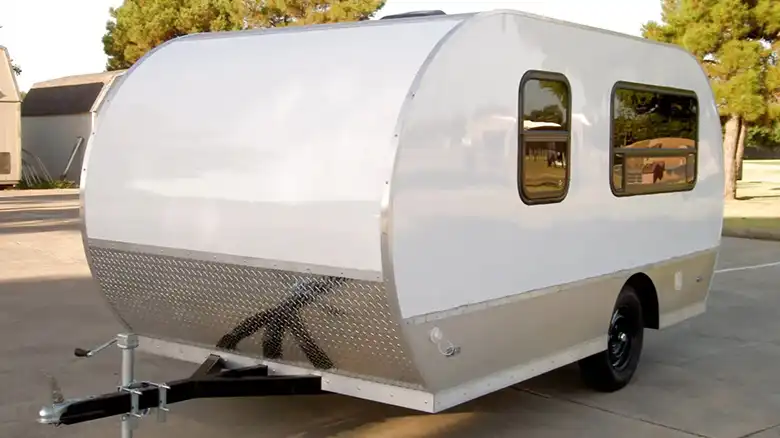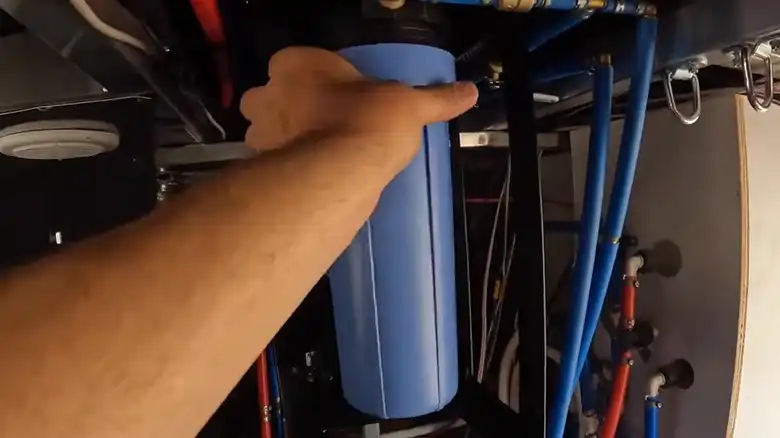The tranquil serenity of kayaking and the roaming freedom of the open road in a fifth wheel camper. Merging these two passions, however, presents a logistical challenge: how do you haul your beloved kayak with your camper in tow?
With some preparation, a bit of equipment, and safety in mind, transporting your kayak with your fifth wheel can be smoother than you think.
Before you set out on your next epic journey that combines paddling and RVing, let’s dive deep into the nuances of hauling your kayak with your fifth-wheel camper effectively.
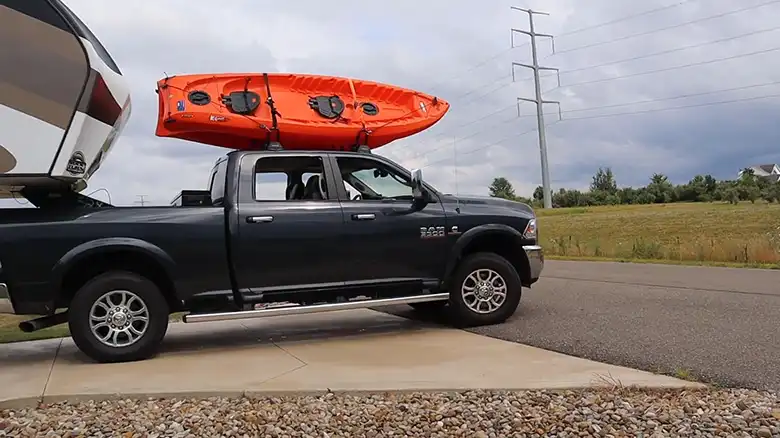
Introduction to Kayak Hauling with Fifth Wheel Campers
Fifth-wheel campers, with their impressive size and the need for a special hitch, can make kayak transportation seem daunting. Traditional methods like roof racks on your towing vehicle might not be feasible. The key is to think a bit outside the box – or, in this case, outside the camper.
1. The Best Option: Using a Kayak Trailer
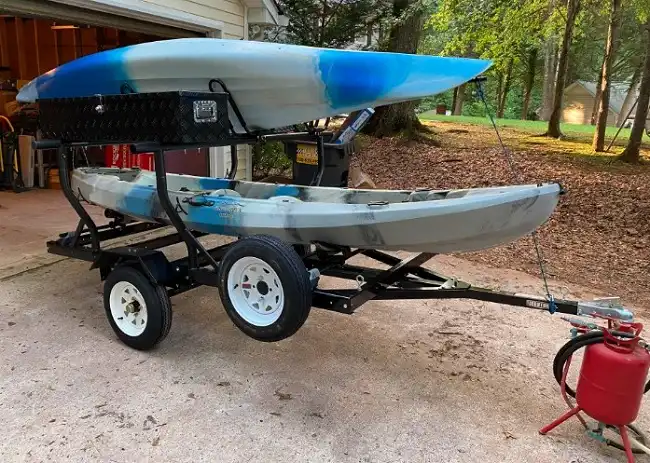
Step 1: Choose a lightweight kayak trailer that can comfortably hold all your kayaks.
Step 2: Check your fifth wheel’s towing capacity to ensure it can handle the extra load.
Step 3: Attach the trailer hitch to the rear of the fifth wheel, ensuring it’s securely fastened.
Step 4: Place and secure the kayaks on the trailer, using tie-downs and straps.
Step 5: Double-check all attachments and regularly inspect during your trip.
2. Installing a Kayak Rack on Your Truck Roof
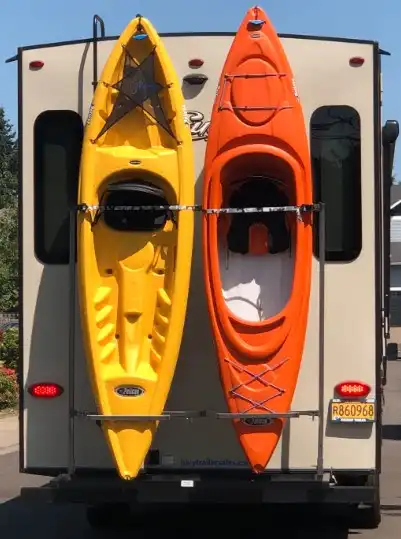
Step 1: Purchase a sturdy roof rack system that fits your truck and can accommodate the size and weight of your kayaks.
Step 2: Install the rack on your truck’s roof according to the manufacturer’s instructions.
Step 3: Lift the kayaks onto the roof rack. This might require two people or specialized lifting equipment.
Step 4: Secure the kayaks using straps, ensuring they’re tight and the kayaks don’t move.
Step 5: Periodically check the kayaks during transit, especially after bumpy sections of road.
3. Hitch-Mounted Kayak Racks for Easy Transportation
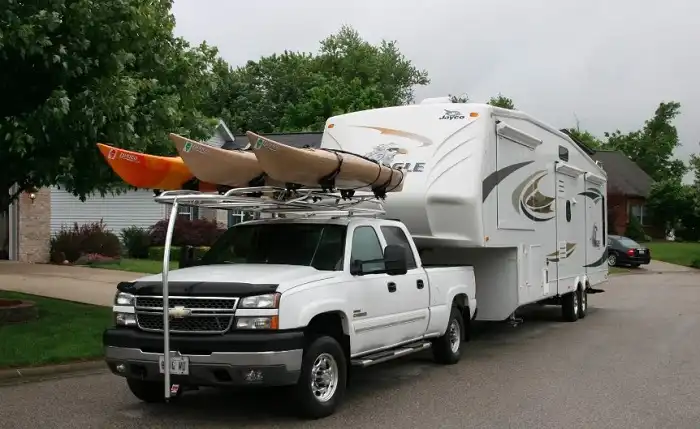
Step 1: Choose a hitch-mounted kayak rack that fits the rear hitch of your fifth wheel.
Step 2: Slide the rack into the hitch and secure it using the provided pins or locks.
Step 3: Mount the kayaks onto the rack, following the design – some hold them horizontally while others might be vertical.
Step 4: Fasten the kayaks using straps or the rack’s securing mechanism.
Step 5: Ensure the kayaks don’t obscure tail lights or number plates.
4. How to Adapt Your Camper’s Ladder for Kayak Storage
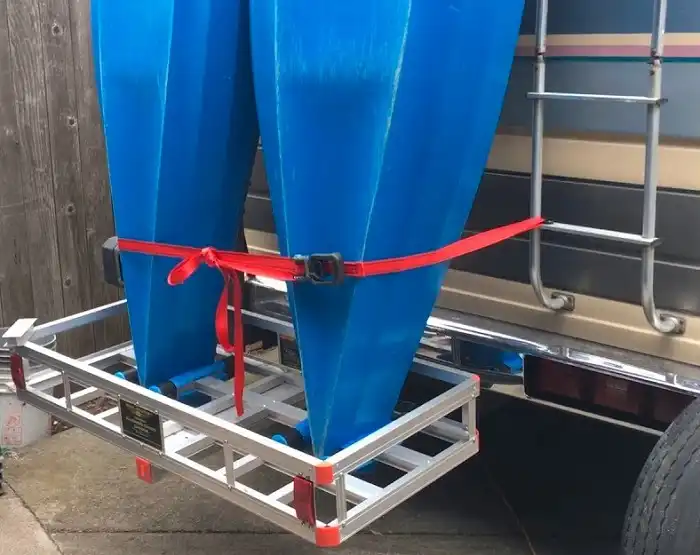
Step 1: Inspect your camper’s ladder to ensure it’s sturdy and can bear the weight of your kayak.
Step 2: Purchase or design brackets that can be securely attached to the ladder.
Step 3: Fix the brackets onto the ladder, ensuring they’re evenly spaced and can support the kayak’s length.
Step 4: Lift and place the kayak onto the brackets.
Step 5: Secure the kayak using straps, making sure it’s stable and won’t shift during travel.
Essential Safety Measures for Kayak Transport
- Regularly Check Attachments: Ensure all mountings, racks, and ties are secure. Regularly stop and inspect during your journey.
- Maintain Visibility: Ensure that kayaks don’t block rearview mirrors or backup cameras.
- Practice Driving: Before embarking on a long journey, practice driving, turning, and reversing with the kayaks attached.
- Check Local Laws: As mentioned, double towing isn’t legal everywhere. Additionally, the total length of your vehicle, fifth wheel, and any additional trailer should be within legal limits.
Packing and Safeguarding Your Kayak
- Use Padding: Prevent scratches or dents by padding your kayak, especially at contact points.
- Secure Loose Items: Ensure all hatch covers, seats, and accessories are secured or removed.
- Weather Protection: If traveling through rainy or snowy areas, consider using a kayak cover.
Final Thoughts
Marrying the thrill of kayaking with the joys of RVing might seem complicated, but with the right strategies, it’s entirely feasible. As you listen to the gentle lapping of water against your kayak, parked beside your fifth wheel under a canopy of stars, you’ll know the effort was worth it. Safe travels and even safer paddling!
Further Inquiries
What’s the best kayak for RVing?
Inflatable kayaks are gaining popularity among RVers due to their compact size and ease of storage.
Can I double tow in all states?
No, double towing laws vary. Check the regulations for each state you plan to travel through.
Is it safe to leave kayaks outdoors overnight?
It depends on the location. Use a lock and cable to secure them and opt for well-lit, secure areas.
How should I store my kayak while camping?
Storing it upside down or on its side, elevated off the ground, helps prevent damage and deters theft. Use a cable and lock for extra security.
What kind of maintenance does a kayak need after traveling?
Rinse with fresh water to remove road salts or debris. Check for any damages, especially if you’ve traveled on rough roads.
Can I use a cover for my kayak while traveling?
Yes, a cover can protect your kayak from dust, debris, and direct sunlight. Ensure it’s tightly secured to prevent it from coming off during travel.
How do I ensure my kayak doesn’t get stolen?
Always use locking mechanisms. When camped, try to keep the kayak in a visible area or store it inside your RV if possible.
Is there a weight limit for rooftop kayak carriers?
Yes, always check the manufacturer’s weight limits on both the carrier and your vehicle’s roof before loading.
What are the best brands for kayak trailers?
Some of the popular brands include Malone, Yakima, and SylvanSport. However, always read reviews and ensure the trailer meets your specific needs.
How can I make my kayak more aerodynamic during travel?
Using a streamlined cover, positioning the kayak with the cockpit facing down, and ensuring it’s centered on your vehicle or trailer can help reduce drag.

